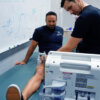Reading research can be a challenging task for those who are not experienced and educated to read scientific publications. Before being able to interpret results and findings from research, it's necessary to understand the layout and how to read a study. Most peer-reviewed journal publications follow a similar and general format, with minor differences. Understanding the general layout of publications will make it easier to identify key details of studies and understand the findings and takeaways. This section of the guide focuses on how to read scientific studies and interpret their findings. After we cover the general layout and briefly describe each section of a published study, we will cover basic statistics and dig into challenges faced by researchers in exercise and nutritional science. We will finish this section with how to trust studies and evaluate studies reporting conflicting findings.
General Format
The author line of publications follows a specific order. The first author is the one who coordinated and had the largest role or responsibility in the study. Generally, if this is a graduate student’s project or thesis their mentor or supervisor will be listed last. The remaining order of authors will be based on their level of contribution. The general format for peer-reviewed, academic publications include five sections known as the introduction, methods, results, discussion, and conclusion. The abstract is another section, but it is separate from the actual publication.
Abstract
After the study title and author line you will find the abstract. The abstract is a paragraph summary of the study. The abstract includes one to two sentences from each of the sections of the publication. Don’t be an abstract warrior and only read the abstract to report what the study found. The details are important, and findings are accompanied with caveats.
Introduction
Independent variables are what is being manipulated by the researcher to determine the relationship or The introduction is the first section of all publications. The introduction includes a discussion of recent and previous studies that relate to the current study of interest. Intro’s start with more general background information and progress into key details and publications that apply to the current study. The intro also discusses any controversies between theories or hypotheses and highlights the importance for the current study. The intro includes two key pieces of the study known as the purpose and the hypothesis:
Purpose







